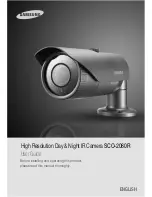
Page 2
© 2003 Bosch Security Systems
DS939 Installation Instructions
•
If necessary, you may remove the base from the cover by pressing the
two cover release tabs
inward while lifting the base away from the
cover.
•
Route wiring as necessary to the rear of the base and through the center
hole.
Note:
Be sure all wiring is de-energized before routing.
•
Firmly mount the base. Depending on local regulations, the base may
be directly surface mounted using anchors, mollies, or wing-nuts. It may
also be mounted to standard 3.5 in. octagonal electrical box. The
detector may also be connected directly to short lengths (short enough
to avoid movement of the detector) of ½ in. (1.27 cm) EMT.
Hint:
Mounting to removable ceiling tiles is not recommended unless a
sandwich is made of the base, ceiling tile, and a back plate behind
the tile.
Mounting Base
Wire entrance and/or EMT Mounting.
Mounting holes.
Tamper Post.
Wire entrance for surface mounting.
Holes for cable ties.
Note:
Using the curved mounting slots
allows the detector to be
rotated up to 60° to obtain the desired coverage.
•
If ceiling tamper is desired, loosen the tamper post by cutting the 3 tabs
and mount the post to the ceiling using a #8 screw
.
5.0
Wiring
CAUTION
Only apply power after all connections have been
made and inspected. Do not coil excess wiring inside
detector.
Note:
Input power must use only a Listed Limited Power Source. Some
countries require that the Alarm and Tamper Contacts be
connected to a SELV (Safety Extra-Low Voltage) circuit only.
-
+
NO
C
NC
T
T
M
ALARM
TAMPER
POWER
+
-
•
Terminals 1 (-) & 2 (+): Power limits are 9 to 15 VDC. Use no smaller
than #22 AWG (0.8 mm) wire pair between the unit and the power
source.
•
Terminals 3 (NO), 4 (C), & 5 (NC): Alarm relay contacts rated 125 mA,
28 VDC maximum for DC resistive loads. Use terminals 4 & 5 for
Normally Closed circuits. Do not use with capacitive or inductive loads.
•
Terminals 6 (T) & 7 (T): Normally Closed tamper contacts rated at 28
VDC, 125 mA.
•
Terminal 8 (M): The memory mode requires a supply voltage on
Terminal 8 to be activated. See Section 8.1 for operation and wiring
information.
6.0
LED Operation
The detector uses a red LED to indicate the various alarm and supervision
conditions that may exist. See chart below.
LED
Cause
Steady red
Unit alarm
Flashing red
Warmup period after power-up
7.0
Feature Selection
HIGH
LOW
ON
OFF
PIR Signal
Gain
7.1
PIR Sensitivity Selection Pins
For selection, place the plug across the appropriate pins. No jumper across
the "HIGH/LOW" pins puts the detector in a "High" setting.
•
Low Sensitivity (LO): The recommended setting for most installations.
This setting tolerates environment extremes. The detector is shipped
in Low Sensitivity mode.
•
High Sensitivity (HI): Use in locations where adequate catch
performance is not achieved in the Low Sensitivity mode. This setting
tolerates only minor environmental changes.
7.2
LED On/Off Pins
The ON position allows operation of the LED. If LED indication is not desired
after setup and walk tests are completed, place in the OFF position. No
jumper across the "ON/OFF" pins disables the LED.
•
Walk test the unit from all directions to determine all the detection
pattern boundaries.
Note:
Wait at least 2 minutes after power up before walk testing.






















